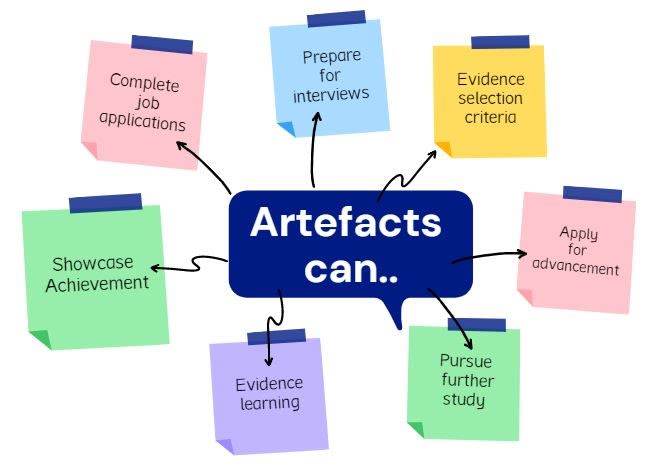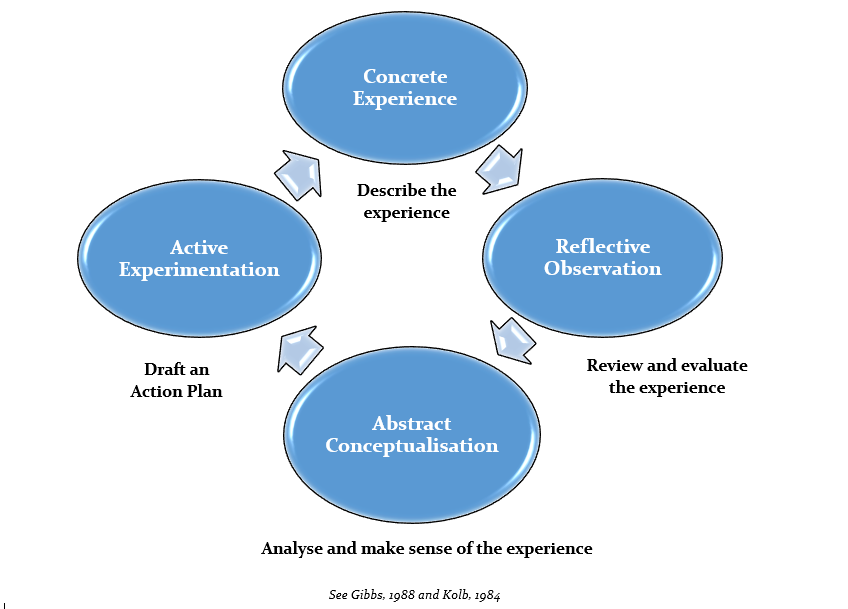Portfolio Artefacts Module in Bookcase

Your portfolio is where the evidence of your progress, learning and achievement is stored. This module explores the purpose of artefacts uploaded to your Employability Portfolio and what kinds of artefact might be included to document your learning journey.
Objectives
On the completion of this module you will learn:
- What artefacts are
- Why you collect or create them
- Where you upload them
- How to write journal entries, explanatory notes and reflections
Introduction
As you progress through your studies, you will collect evidence of your academic, professional and personal development and include this in your Employability Portfolio. At University College, we often refer to anything that evidences your skill development or overall learning as an ‘artefact’. And, these artefacts can be in various formats, for example, electronic files, audio or video, images, diagrams, journal entries, graphics and more.
If you have not yet explored what the Employability Portfolio is, please click on the module below:

Evidence in your Employability Portfolio
Throughout your studies, you will collect and upload artefacts (also called ‘evidence’, ‘assets’, ‘workbooks’, ‘objects’ and ‘items’) to your Employability Portfolio that highlight:
- How you have developed various employability skills and attributes (these are skills that are ‘transferable’ to any job content – see above examples)
- The way you have applied your learning in practice
- How you have developed skills in a chosen field e.g., business, health, science, design, technology, agribusiness, or construction
If you collect and upload this evidence from the beginning to the end of your studies, you will finish at UC with a complete portfolio. Your employability portfolio will then be a valuable resource to use for job preparation or career advancement.

Artefacts (evidence)
We mentioned that artefacts are evidence of achievement, skills development and overall learning. And, we touched on how collecting and uploading them creates a valuable resource at the end of the program of study. The below list includes a broader range of examples of what artefacts/evidence might include:
- electronic files and written text
- explanatory notes or reflections
- images, photographs, graphics
- videos, podcasts, presentations
- diagrams, mind maps, flow charts
- presentations, photographic essays, posters
- fieldnotes (from projects, industry site visits or fieldwork)
- interview panel questions, industry expert interviews
- planning tools or techniques (e.g. SWOT, PESTLE, Business Model Canvas, Value Chain Maps)
- timelines, postcards, collages
- placement journals
In many cases, ‘artefacts’ are often assessment tasks, or ‘items’ you have worked on – so you already have them to upload!
See the diagram below and click on the + signs!
Journal Entries, Explanatory Notes and Reflections
At University College, you will be asked regularly to write journal entries, explanatory notes and reflections. These will require you to reflect on experiences and key learnings, skills developed, situations you found challenging, moments of insight, industry observations or practices and concepts, terms and ideas.
Reflection may be described as the act of engaging in careful thought about an experience to:
1. Help us make meaningful sense of it, and
2. Support us to make better decisions for the benefit of ourselves and others
The journal entries, explanatory notes and reflections that you write might be about:
- What you do, what you observe and what you learn e.g. during practical experiences and when engaging with industry and community
- How you applied theory to practice e.g., how you drew on discipline knowledge or used a tool or technique to do something in a workplace or a community context
- How you would apply what you learnt from an experience in other situations in the future
- Skills you developed or need to develop
- New business or learning goals that you set yourself because of a learning experience
Typically, when you upload artefacts/evidence you will be asked to do so with an ‘explanatory note’ attached to them (or a reflection or journal entry).
When you write these reflective pieces, we recommend you follow a format we have adapted from key theorists in this area.
To help you to do this, we have included below a diagram of the reflective cycle adapted from the work of Kolb (1984) and Gibbs (1988) which you can use to guide how you write your explanatory notes (or journal entries, or reflections). The diagram is followed by some examples of artefacts and explanatory notes.
The Reflective Cycle (Adapted from Kolb, 1984; and Gibbs, 1988)

In short, the first step requires you to describe the experience itself. From there, you review and evaluate it. You follow on to analyse and make sense of the experience, and then draft a plan for future action (or notes for future action) based on what you have learnt.
If you would like to see a template in PebblePad (partially completed as an example), please click on the button below.
And, if you would like a PebblePad Template to Complete yourself, please click on the button below.
Basic Examples of Artefacts and Explanatory Notes
Please view the slide presentation below for some basic examples of how to write explanatory notes for artefacts/evidence. You may find that you have to click on ‘presenter view’ and click on each slide at your own pace, as it may not transition for you. Or, you may find it does!
Google Slide Presentation
Recap
- Throughout your studies, you will collect and upload artefacts (also called ‘evidence’, ‘assets’, ‘workbooks’ and ‘items’) to your Employability Portfolio
- The Employability Portfolio is created in PebblePad and contains all University College portfolio requirements for the course
- Artefacts/evidence may include any range of items that highlight your achievement, progress, key learnings and reflect academic, professional and personal development
- In many cases, you will need to ensure artefacts (e.g., those that are images, graphs or sketches) are accompanied by journal entries, explanatory notes and reflections – to unpack the meaning behind them
- A basic adapted ‘reflective cycle’ has been included in this module to guide how to write these explanatory notes (or journal entries and reflections)
- Some examples are provided in the Google Slide
- For more detail and information, please return to the Employability Portfolio module
References
Gibbs, G 1988, Learning by doing: a guide to teaching and learning methods, Further Education Unit, Oxford Brookes University.
Kolb, DA 1984, Experiential learning: Experience as the source of learning and development, Vol. 1, Prentice-Hall ,Englewood Cliffs, NJ.